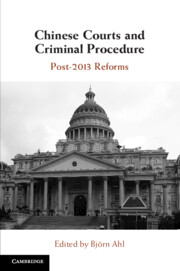Book contents
- Chinese Courts and Criminal Procedure
- Chinese Courts and Criminal Procedure
- Copyright page
- Contents
- Figures and Tables
- Contributors
- Acknowledgements
- Abbreviations
- 1 Post-2013 Reforms of the Chinese Courts and Criminal Procedure
- 2 The Meandering Path of Judicial Reform with Chinese Characteristics
- 3 Dimensions and Contradictions of Judicial Reforms in China
- 4 How the Supreme People’s Court Drafts Criminal Procedure Judicial Interpretations
- 5 Judicial (Dis)Empowerment and Centralisation Efforts
- 6 A New Model of Habeas Corpus in China? Procuratorial Necessity Examination of Pretrial Custody
- 7 Live Witness Testimony in the Chinese Criminal Courts
- 8 Blood Money and Negotiated Justice in China
- 9 Performance Evaluation in the Context of Criminal Justice Reform
- 10 From Populism to Professionalism
- Index
3 - Dimensions and Contradictions of Judicial Reforms in China
Published online by Cambridge University Press: 25 June 2021
- Chinese Courts and Criminal Procedure
- Chinese Courts and Criminal Procedure
- Copyright page
- Contents
- Figures and Tables
- Contributors
- Acknowledgements
- Abbreviations
- 1 Post-2013 Reforms of the Chinese Courts and Criminal Procedure
- 2 The Meandering Path of Judicial Reform with Chinese Characteristics
- 3 Dimensions and Contradictions of Judicial Reforms in China
- 4 How the Supreme People’s Court Drafts Criminal Procedure Judicial Interpretations
- 5 Judicial (Dis)Empowerment and Centralisation Efforts
- 6 A New Model of Habeas Corpus in China? Procuratorial Necessity Examination of Pretrial Custody
- 7 Live Witness Testimony in the Chinese Criminal Courts
- 8 Blood Money and Negotiated Justice in China
- 9 Performance Evaluation in the Context of Criminal Justice Reform
- 10 From Populism to Professionalism
- Index
Summary
This chapter investigates the development of judicial reforms and discusses recent changes of court management and the roles of judges within courts. It further sets out the contributions that civil procedure reforms made to the institutional changes effected in the judiciary during the early court reforms of the 1990s. The aim of the reforms to the civil procedure system was to adjust the role of the courts vis-à-vis litigants to protect the latter’s procedural rights and check judicial power. The readjustment of the relation between judges and the parties to a civil trial, and the underlying academic discourse supporting it, promoted judicial transparency and legal professionalism. It also spurred discussion of broader reforms targeting judicial independence. For example, changes were made to the bureaucratic management structure of the courts. Efforts have also been made to protect the independence of the courts by shielding them from local government interference. Despite these well-intended measures, however, the transformation of bureaucratic court management into mechanisms of trial accountability has encountered obstacles in practice. Courts operate according to both a legal and political logic, and institutional reforms can achieve success only if they take both into account.
- Type
- Chapter
- Information
- Chinese Courts and Criminal ProcedurePost-2013 Reforms, pp. 59 - 83Publisher: Cambridge University PressPrint publication year: 2021
- 1
- Cited by



